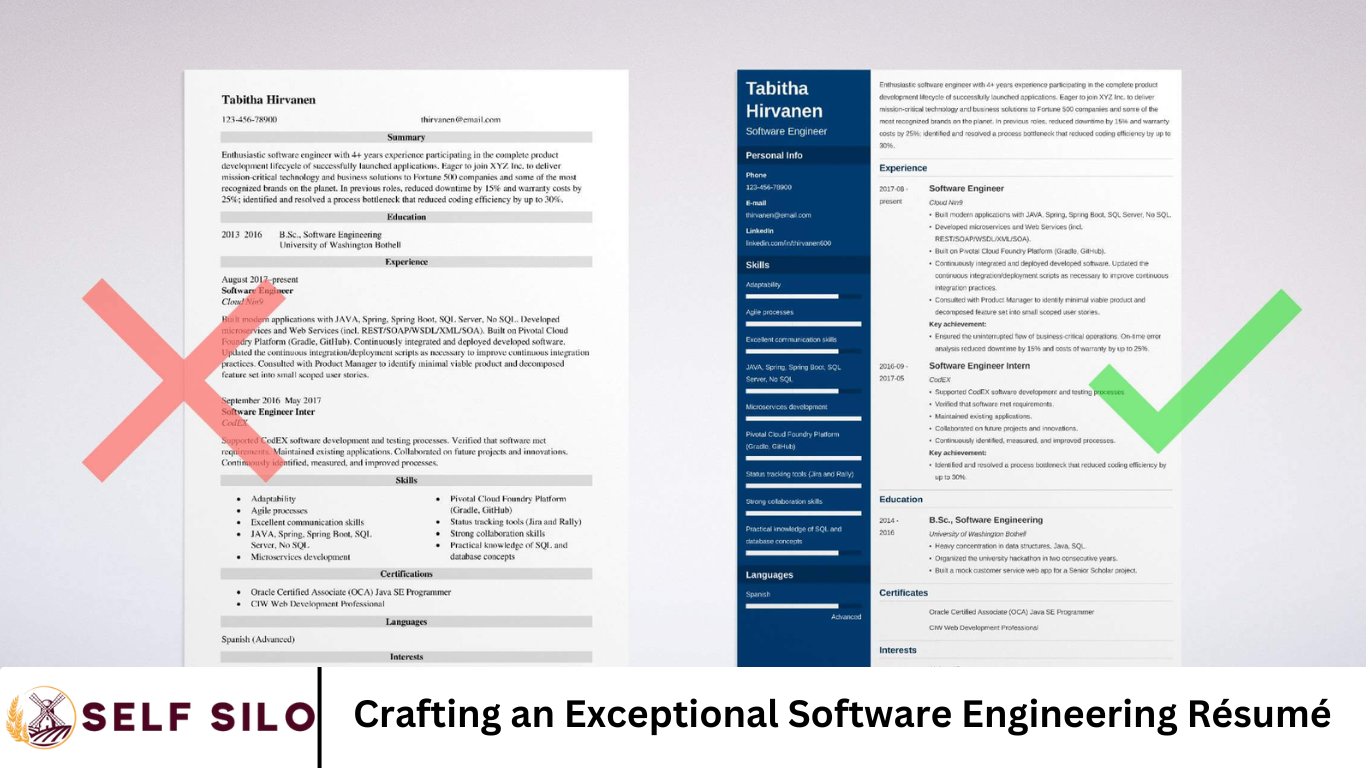Competitive tech job market, your résumé is more than just a document — it’s your first impression. Recruiters spend an average of 6–8 seconds scanning a résumé before deciding if it’s worth a deeper look. For software engineers, the stakes are even higher, as your résumé must strike a balance between technical depth and concise readability.
Whether you’re a recent computer science graduate or a seasoned backend engineer, this guide will walk you through how to write a standout software engineering résumé that lands interviews and accelerates your career growth.
More Read: The Job Seeker’s Guide to Salary Negotiation and Fair Compensation
Why Your Software Engineering Résumé Matters
Despite the rise of LinkedIn, portfolios, and GitHub, the résumé remains the primary tool recruiters use to screen candidates. A compelling résumé can:
- Help you pass through Applicant Tracking Systems (ATS)
- Convey your technical and soft skills quickly
- Demonstrate real-world impact from your work
- Differentiate you in a crowded field
In short, crafting an exceptional résumé is not optional—it’s essential.
Step-by-Step Guide to Writing an Outstanding Software Engineering Résumé
1. Start With a Clean, Professional Format
A messy or poorly structured résumé will get tossed instantly. Use a clean layout with consistent formatting. Keep it to one page if you have less than 10 years of experience, and no more than two pages otherwise.
Formatting tips:
- Use a modern font like Calibri, Helvetica, or Arial
- Stick to 11–12 pt font size
- Use bullet points to improve scannability
- Save and send as a PDF to preserve formatting
Tools to help:
- Canva (free templates)
- Overleaf (for LaTeX users)
- Novoresume or Resume.io
2. Write a Tailored Professional Summary (Not an Objective)
Avoid generic objectives like “Seeking a challenging software role…” Instead, craft a Professional Summary that highlights your unique value proposition.
Example:
Full-stack software engineer with 5+ years of experience building scalable web applications in JavaScript, React, and Node.js. Passionate about clean code, agile methodologies, and solving real-world problems through innovative solutions.
Tailor this section to the job description, using keywords that align with the position.
3. Highlight Relevant Technical Skills (with Context)
List your technical skills clearly, but avoid stuffing keywords. Group them by category (e.g., Languages, Frameworks, Tools).
Example format:
Technical Skills:
- Languages: Python, JavaScript, Go, Java
- Frameworks: React, Node.js, Django, Flask
- Tools: Docker, Kubernetes, Git, Jenkins, AWS
Optionally, include a proficiency scale or years of experience, but only if it’s accurate.
Bonus Tip: Don’t just list your tech stack — demonstrate how you used it in your experience section.
4. Showcase Experience With Measurable Impact
This is the heart of your résumé. Don’t just list responsibilities — show impact.
Use the STAR method (Situation, Task, Action, Result) to describe each experience with action verbs and quantifiable achievements.
Bad Example:
- Worked on backend systems
Great Example:
- Designed and implemented RESTful APIs in Django, improving data processing speed by 40% and reducing server costs by $20K/year.
Checklist:
- Start with an action verb (e.g., Developed, Led, Optimized, Scaled)
- Mention technologies used
- Include metrics or outcomes (time saved, revenue increased, performance improved)
5. Optimize for Applicant Tracking Systems (ATS)
Most companies use ATS software to filter applications. To beat the bots:
- Use exact keywords from the job description
- Avoid using images, graphics, or tables
- Use standard section headings like “Experience,” “Education,” “Skills”
- Save as a PDF or .docx (check job posting preferences)
Use tools like Jobscan to check how well your résumé matches the job post.
6. Include Side Projects, Open Source Contributions, or Freelance Work
Hiring managers love to see personal projects — they show passion, initiative, and creativity.
Examples:
- Built a personal finance app using React Native and Firebase with 500+ downloads on Google Play
- Contributed to the open-source library
fastapi— fixed bugs and wrote unit tests for authentication module
Link to GitHub, portfolio, or project demos where appropriate.
7. Mention Certifications and Continued Learning
The tech world evolves fast. Show that you’re keeping up.
Relevant certifications:
- AWS Certified Solutions Architect
- Google Cloud Professional Engineer
- CS50x (Harvard’s Intro to CS)
- Coursera/MOOCs in Data Structures, Algorithms, or Machine Learning
Don’t overdo it — only list certifications that are recognizable and relevant.
8. Education Section: Be Concise and Relevant
Place education at the top if you’re a new grad; otherwise, place it after experience.
Example format:
Bachelor of Science in Computer Science
University of California, Berkeley — May 2022
GPA: 3.8/4.0 | Coursework: Algorithms, Operating Systems, AI, Databases
Include honors, scholarships, or relevant coursework only if they strengthen your candidacy.
9. Add Links to GitHub, LinkedIn, and Portfolio
Place these at the top of your résumé with your contact info.
Example:
yamlCopyEditEmail: johndoe@gmail.com | GitHub: github.com/johndoe | LinkedIn: linkedin.com/in/johndoe | Portfolio: johndoe.dev
Make sure all links are clickable, especially on PDFs.
Common Mistakes to Avoid
- Too much text – Avoid long paragraphs; stick to concise bullet points.
- Typos and grammar errors – Use Grammarly or ask a friend to proofread.
- Irrelevant experience – Focus on what’s relevant to software engineering.
- Listing duties, not achievements – Emphasize results, not tasks.
- Not tailoring the résumé – Customize your résumé for each role.
Sample Software Engineer Résumé (Outline)
John Smith
Email | GitHub | LinkedIn | Portfolio
Professional Summary
Full-stack software engineer with 4+ years of experience developing scalable, cloud-native web applications. Specializes in React, Node.js, and AWS with a strong focus on performance optimization and agile development.
Technical Skills
Languages: JavaScript, Python, Go
Frameworks: React, Express, Django
Tools: Git, Docker, Jenkins, AWS, SQL, MongoDB
Experience
Software Engineer – Stripe
San Francisco, CA | July 2021 – Present
- Developed API integration for payment platform, reducing transaction latency by 25%
- Led migration from monolith to microservices architecture using Docker and Kubernetes
- Collaborated with product team to roll out new checkout UI used by 10,000+ merchants
Junior Developer – CodeWave
Remote | June 2019 – June 2021
- Built and maintained internal admin tools in Vue.js and Node.js
- Automated deployment process with Jenkins and Docker, cutting release time by 50%
- Mentored two interns and conducted weekly code reviews
Education
B.S. in Computer Science – University of Washington
GPA: 3.7/4.0 | Relevant Coursework: Data Structures, Systems Programming
Certifications
AWS Certified Developer – Associate
CS50x – Harvard University
Frequently Asked Question
What should I include in a software engineering résumé?**
A strong software engineering résumé should include:
- A professional summary
- Technical skills (languages, frameworks, tools)
- Work experience with measurable results
- Projects (personal, freelance, open source)
- Education and certifications
- Links to GitHub, LinkedIn, and portfolio
Make sure everything is relevant and tailored to the specific job you’re applying for.
How long should my software engineering résumé be?**
Keep your résumé one page if you have less than 10 years of experience. If you’re more senior or have extensive projects/publications, two pages is acceptable. The key is clarity and relevance—avoid fluff.
What are the best skills to list for software engineering roles?**
The best skills are those that match the job description. Commonly sought-after skills include:
- Languages: Python, JavaScript, Java, C++
- Frameworks: React, Node.js, Django, Spring Boot
- Tools: Git, Docker, Kubernetes, Jenkins, AWS
Also include methodologies like Agile, TDD, or CI/CD pipelines if applicable.
How do I make my software engineering résumé stand out?**
To stand out:
- Show impact with numbers (e.g., “reduced load time by 30%”)
- Include personal projects or open source contributions
- Tailor your résumé with keywords from the job posting
- Keep the design clean and professional
Customizing each résumé for the role significantly improves your chances.
Should I include non-technical jobs on my software engineering résumé?**
Only include non-technical jobs if they:
- Demonstrate transferable skills (e.g., leadership, communication)
- Show a clear career progression
- Fill a gap in your employment history
Otherwise, focus on relevant technical experience and projects.
How can I pass Applicant Tracking Systems (ATS) with my résumé?**
To beat ATS software:
- Use standard section headings (e.g., “Experience,” “Skills”)
- Match your résumé with keywords from the job description
- Avoid tables, graphics, or images
- Submit your résumé in PDF or .docx format, unless otherwise requested
Tools like Jobscan can help optimize your résumé for ATS compatibility.
Do I need a cover letter along with my résumé?**
While not always required, a well-written cover letter can set you apart by:
- Showing your enthusiasm for the company
- Highlighting specific achievements
- Explaining career gaps or transitions
If a cover letter is optional, include one—especially if the company is competitive or values communication skills.
Conclusion
An exceptional software engineering résumé is more than a list of jobs and technologies — it’s a strategic tool that markets your strengths, tells your story, and opens doors to career-defining opportunities. By focusing on clarity, relevance, measurable impact, and alignment with job descriptions, you significantly increase your chances of standing out in a competitive field.


